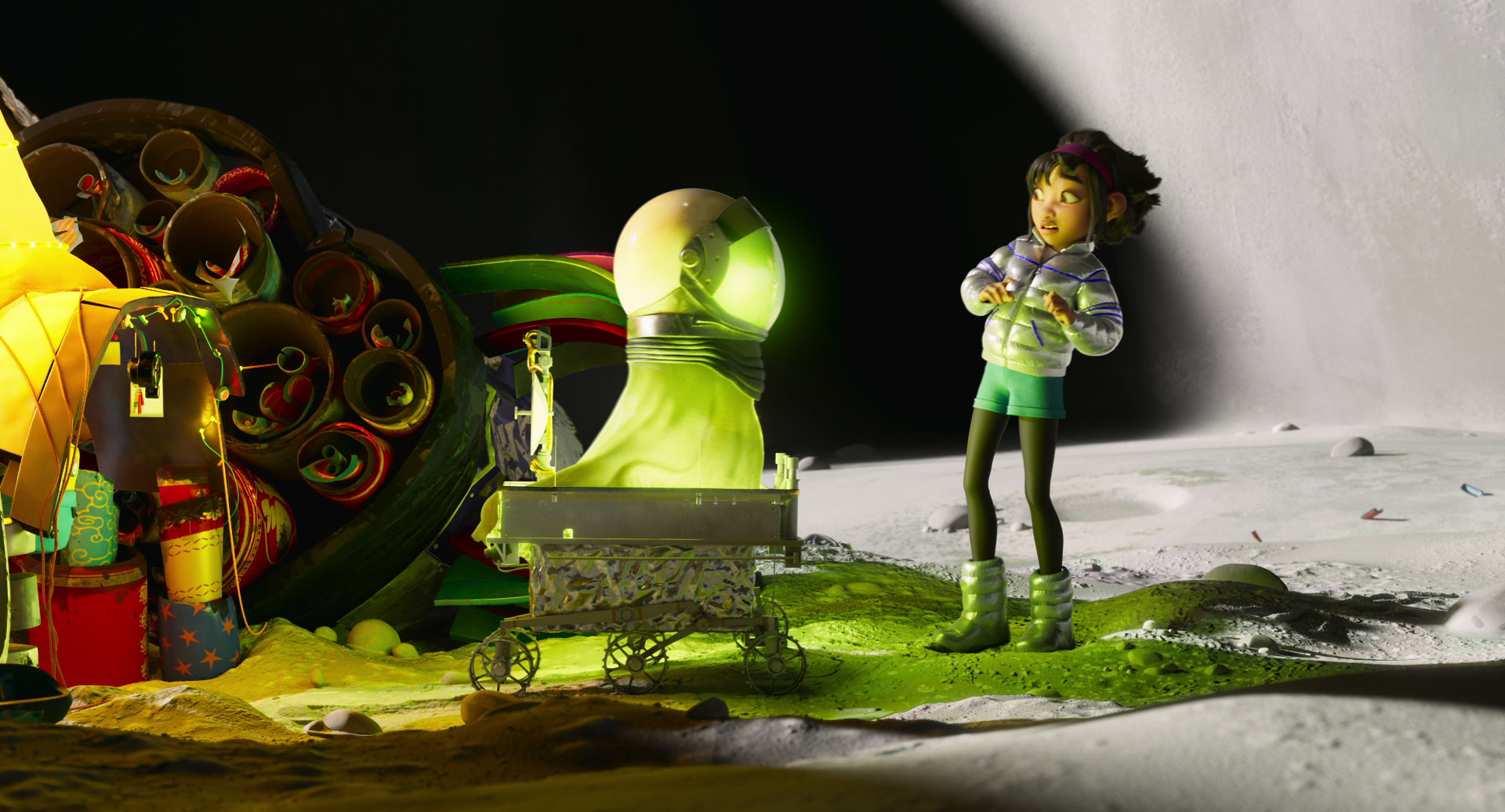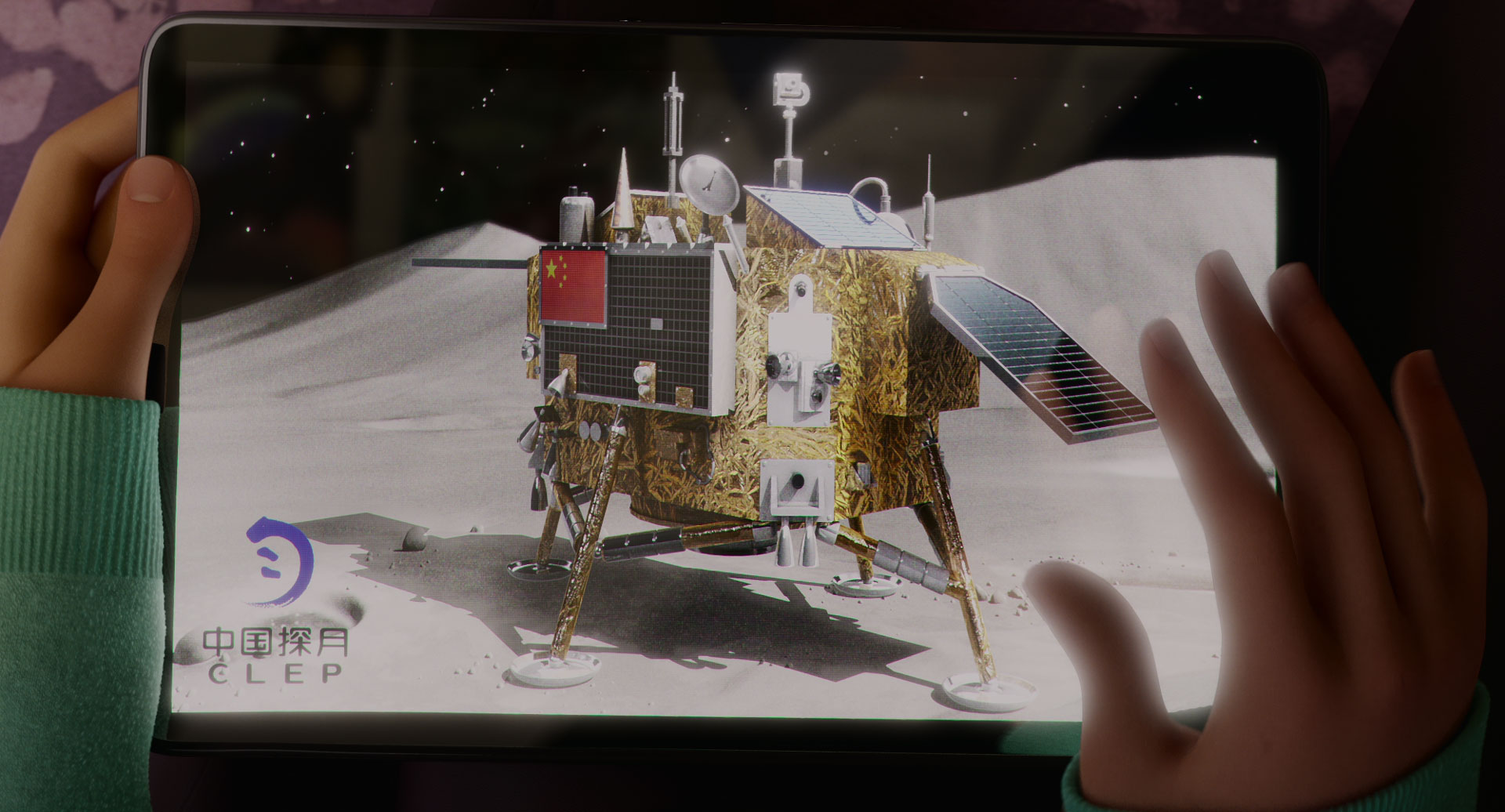China's real lunar rover rolls 'Over the Moon' in Netflix animated film

China's lunar rover helped animators add what Walt Disney once called the "plausible impossible" to the new animated film "Over the Moon."
The Yutu rover and its Chang'e lander make brief appearances in the Netflix and Pearl Studio movie, which follows the adventures of a young Chinese girl, Fei Fei, who builds a rocket ship to the moon to prove the existence of a moon goddess. The rover and lander's namesakes were taken from a traditional Chinese legend about the immortal Chang'e and her Jade Rabbit ("Yutu" in Chinese) — the same mythology on which "Over the Moon" is based.
"We did not have the lunar rover [in the movie] until about half, maybe about a third of the way through making the film," director Glen Keane said in an interview with collectSPACE. "The idea of putting the lunar rover there seemed like it was a pretty wonderful thing, if we could have it integrated into the story. And that was the challenge."
Related: 20 sci-fi movies and TV shows to binge watch on Netflix
- Want to try Netflix? You can get a 30-day free trial now
- Sign up for Netflix starting at $8.99/month.
The original six-wheeled Yutu and its four-legged Chang'e 3 lander touched down in the Sea of Rains (or Mare Imbrium) in 2013, establishing China as only the third nation to land a spacecraft on the moon. A second rover, Yutu-2, has been making history since 2019 as the first and only probe to explore the side of the moon that always faces away from Earth.
In "Over the Moon," Fei Fei travels to the lunar far side, where she encounters the rover, along with a whimsical land of fantastical creatures.
"You could not have it be just in the background, moving past. It had to be something that was central," Keane said, referring to the rover. "It seemed like it was really important that the moon be real and authentic and a true destination for exploration for a child to dream of becoming an astronaut. To have an actual vehicle on the moon just felt really, really right."
Get the Space.com Newsletter
Breaking space news, the latest updates on rocket launches, skywatching events and more!
"Also, just the idea that it was named 'Jade Rabbit' was even more wonderful," he said. (The mythological Jade Rabbit also appears in the film.)

Keane and his production team worked directly with the Chinese National Space Administration to get the details of the spacecraft correct. The logo for the Chinese Lunar Exploration Program (CLEP) appears in one scene, as does an animated portrait of astronaut Liu Yang, China's first woman in space.
"They were very involved in encouraging us and providing anything that we needed," said Keane. "They supplied us with the actual plans, the designs for the lunar rover from CLEP."
For Keane, adding Yutu to "Over the Moon" helped make some of the film's more imaginative elements more believable. At the same, though, the rover needed to reflect some of that fantasy, too. Its camera mast, for example, became its head, giving it the ability to emote.
"We added the idea that what seemed like a head lifted up high could turn. It just felt like, 'let's use that as a kind attitude that it can go off,'" he said. "And the little beeping sounds that we had the first time Fei Fei sees the rover as she's clicking on her tablet [on Earth] were a really important element. On the moon, you hear it again, connecting the two."

Keane, who was a lead character animator for Walt Disney Animation Studios and was named a Disney Legend for his work, likened the ability to ground a fictional element in reality with what Walt Disney referred to the "plausible impossible." The design of Fei Fei's rocket ship, which employs magnetic levitation, is an example of that quality.
"The idea of a technology that no one really understands quite how it goes gives enough of the plausible impossible to make it all happen," he said.
Keane learned that firsthand, having launched on a similar trip to Fei Fei's — and the audience's — when he was a child. For his seventh birthday in 1961, Keane's father (cartoonist Bil Keane, creator of the comic strip "The Family Circus") told his son that NASA had loaned him a new rocket ship, that it was in their backyard and he and his friends could each go for a ride.
"'But it's top secret,'" Keane recalled his father explaining. "'So you can't see it, but I could blindfold you one by one and we can go on it.'"

Instead of flying into space, the rocket ride would be out into the desert and back. After being strapped in, Keane heard the radio crackle from mission control, felt the wind against his face and a splash of water as they flew past a lake. Finally, the rocket landed and the blindfold was removed.
"And there's my mom and dad on either side of the lawn chair that they lifted. And there's the short wave radio and the swimming pool," he recalled. "And the coolest thing was, I wasn't disappointed. I realized it was all happening in my imagination."
"Now I get to do the same thing for everyone [watching 'Over the Moon']. In effect, I'm putting a blindfold of imagination, animation, around you, and you are going to experience everything the way I experienced it," he said.
"All you need is that plausible impossible."
"Over the Moon," directed by Glen Keane based on a screenplay by Audrey Wells and starring Cathy Ang, Phillipa Soo and Ken Jeong, is now streaming on Netflix.
Follow collectSPACE.com on Facebook and on Twitter at @collectSPACE. Copyright 2020 collectSPACE.com. All rights reserved.
Join our Space Forums to keep talking space on the latest missions, night sky and more! And if you have a news tip, correction or comment, let us know at: community@space.com.

Robert Pearlman is a space historian, journalist and the founder and editor of collectSPACE.com, a daily news publication and community devoted to space history with a particular focus on how and where space exploration intersects with pop culture. Pearlman is also a contributing writer for Space.com and co-author of "Space Stations: The Art, Science, and Reality of Working in Space” published by Smithsonian Books in 2018.In 2009, he was inducted into the U.S. Space Camp Hall of Fame in Huntsville, Alabama. In 2021, he was honored by the American Astronautical Society with the Ordway Award for Sustained Excellence in Spaceflight History. In 2023, the National Space Club Florida Committee recognized Pearlman with the Kolcum News and Communications Award for excellence in telling the space story along the Space Coast and throughout the world.










